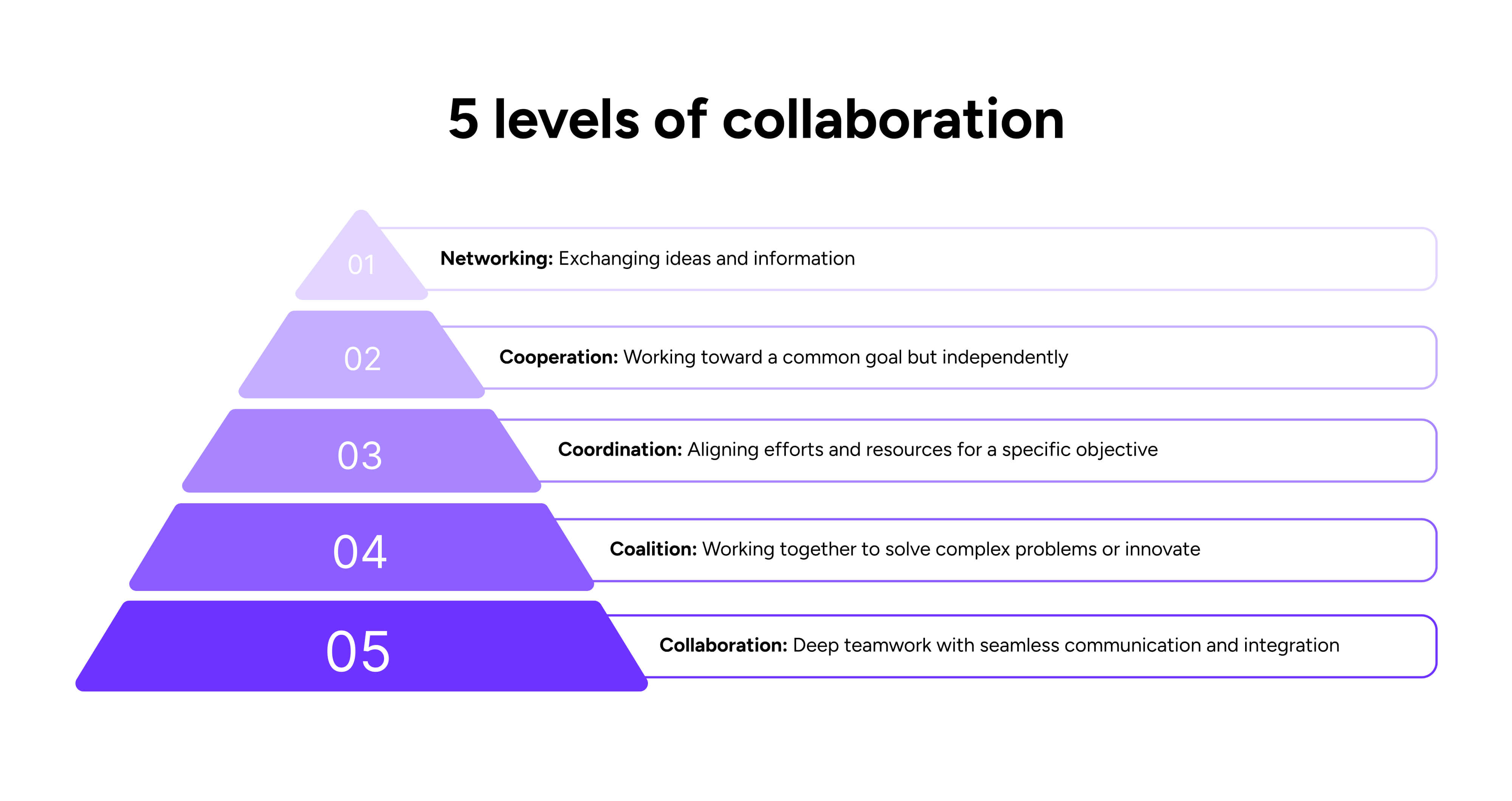Transforming the workplace with digital collaboration
Explore powerful digital collaboration strategies and tools that enable seamless project management, effective communication and streamlined content management.
Explore powerful digital collaboration strategies and tools that enable seamless project management, effective communication and streamlined content management.

By embracing digital collaboration tools and methods, organizations can empower their workforce, enhance communication and improve team productivity. Learn how to future ECM capabilities are transforming the way organization are promoting digital collaboration across teams.
Digital collaboration refers to the use of digital technology and platforms to facilitate teamwork, communication and information sharing — regardless of physical location. It transforms how teams work by enabling real-time collaboration, increasing accessibility and enhancing efficiency.
When correctly executed, digital collaboration breaks down barriers to communication, allowing for agile and flexible interactions across departments, team members and time zones.
Traditional collaboration typically relies on in-person interactions; digital collaboration uses technology to enable real-time remote connections.
Traditional communication methods were built around getting together in person, which limits collaboration to specific times and places. They also significantly restrict the speed and breadth of interactions, depending mainly on teammates’ schedules for conversation or physical document exchange to share and distribute information.
Meanwhile, digital collaboration technologies allow for more accessible and flexible communication. Employees can work together from anywhere using tools that enable multi-user, real-time collaborative editing, improving remote team productivity. These tools enable team members to track project statuses in real time, send asynchronous messages and store files in a secure central location.

The benefits of digital collaboration are far-reaching, with the potential to transform how teams work and communicate.
Here are some advantages of streamlining digital collaboration processes in your organization:
There's no one-size-fits-all approach when it comes to collaboration. There are different stages of collaboration organizations often go through, with each level building on the previous one.
Here is a brief overview of the five levels of collaboration:

When we talk about networking within the context of collaboration, we’re referring to a basic exchange of ideas, contacts and resources — often without a structured goal or shared objective.
It typically involves one-sided communication, with no expectation of interaction or response.
Cooperation is a more structured form of collaboration where individuals work together toward achieving a common goal or objective.
There's more interdependence and two-way communication at this level but team members still work independently.
At this stage, collaboration becomes more structured and organized. Teams or departments synchronize efforts and align activities, resources and timelines to achieve specific objectives.
Communication and information sharing become more systematic, often leveraging formal methods like email or project management tools for collaboration.
When teams collaborate at this level, they share a common goal and actively work together to achieve it. Multiple departments or organizations may come together to solve a complex problem or innovate on a project.
Besides regular communication, coalition-level collaboration involves joint decision-making and knowledge sharing to leverage each other's strengths and resources.
Collaboration is the pinnacle of teamwork and involves high levels of trust, communication and integration among team members. At this stage, teams have well-defined roles and responsibilities, enabling them to work together on highly complex projects.
Teams collaborate in real time through seamless communication channels, using digital tools that enable agile interactions for efficient decision-making and problem-solving.
Digital collaboration can take many forms depending on the context and purpose. Let's explore some common types of collaboration relevant to the modern workplace:

Explore Gartner’s analysis of 15 vendors in the document management space, and see why Hyland was named a Challenger with strengths in our scalability, open source and industry-specific capabilities.
While digital-first work may seem like the new norm, it's still a relatively new concept for many organizations.
Here are some actionable strategies to help your team optimize digital collaboration:
It's easy enough to check the box of "communication" within an organization by sending out regular emails and scheduling recurring team meetings. However, open communication goes beyond these basic interactions.
To foster a culture of open communication, a few good practices to implement include:
With numerous digital collaboration tools available, it's essential to choose the right ones that align with your organization’s overall needs and goals.
Consider important factors such as:
Before implementing any digital collaboration tools, make sure they can integrate with your existing workflows, processes and foundational systems such as:
Minimizing the number of tools and platforms used can also help reduce confusion, improve operational efficiency and make it easier for team members to collaborate.
With any new tool or technology, there will be a learning curve for team members.
To maximize adoption and efficiency, provide comprehensive training and ongoing support for the tools you implement. This can include training videos, user guides, FAQs or even workshops.
For more complex tools, consider engaging a dedicated support team or providing access to online resources or forums for troubleshooting.
The best time to define collaboration protocols? Right when you start implementing digital collaboration best practices.
Document processes for communication, file sharing, decision-making and other key aspects of collaboration. This can help avoid confusion or misunderstandings and ensure team members are on the same page at every step.
It's equally important to define who does what at different stages of a workflow. With clear roles and responsibilities, team members know who to turn to for specific tasks or decisions.
Digital platforms can help assign tasks, track progress and manage deadlines, making it easier for team members to stay on top of their responsibilities. Common roles to define include project leads, content creators, reviewers and final approvers.
> Read more | What is a workflow, and why is it important?
As any team knows, collaboration is an ongoing process of trial and error. Encourage team members to share feedback on the effectiveness of your collaboration processes, including the tools used and communication methods.
Regularly evaluate your processes and make necessary adjustments to optimize productivity, efficiency and overall teamwork.
With digital collaboration comes the need to protect sensitive data and information. Ensure your tools and platforms have robust security measures in place, such as encryption, access controls, secure login processes and data backup.
Additionally, educate team members on best practices for keeping data secure, such as:
Finally, make sure to track the impact of your digital collaboration efforts. Determine the right metrics to measure and regularly monitor the effectiveness of your collaboration processes and tools.
This could include measuring factors such as:
You can then use these insights to identify areas for improvement and continuously optimize teamwork within your organization.
— Senior Vice President and CIO, Global Specialty business unit, Liberty Mutual
With the changing landscape of work, there has been an explosion of digital collaboration tools and platforms designed to improve efficiency and enhance teamwork.
Here are some popular types of collaboration tools used by modern teams:
Project management tools such as Asana and Trello are designed to help teams plan, organize and track project tasks and timelines. They often include features like:
These tools make it easier to coordinate between members and ensure projects are completed on time and within budget.
Communication platforms like Zoom or Slack facilitate real-time communication organization-wide through messaging, video conferencing and file sharing.
These tools also often include features such as voice calls and screen sharing, making it easier for team members to collaborate remotely.
Document collaboration tools allow teams to create, store and collaborate on documents in real time. They offer a range of features that enable efficient content creation and review processes.
ECM systems are comprehensive platforms for managing an organization's entire content life cycle, from creation and collaboration to storage and retrieval. They provide a centralized repository for storing and managing all types of content, including documents, images, audio and video files.
Some key document capabilities of ECM systems include:
These capabilities facilitate document collaboration among team members, enabling real-time collaborative editing, annotations and discussions. This leads to faster document creation and review processes, increasing productivity and efficiency for the team.
A modern ECM platform go beyond traditional systems and purpose-built tools to provide a comprehensive solution for digital collaboration.
By integrating with other business applications and providing advanced content management and collaboration capabilities, ECM systems like Hyland Content Innovation Cloud™ use intelligent automation, AI and a unified content approach to help organizations take their digital collaboration efforts to the next level.
Discover what a modern ECM platform can do for your organization and how it can help your team achieve seamless digital collaboration.

Explore the essentials of ECM, its benefits and how it transforms content management to enhance efficiency and compliance in your organization.

Forrester research shows that employees who are equipped with the right digital tools are more likely to be highly engaged.

Find out how improving leadership practices contributes to better business.

Cloud technology removes barriers that organizations historically relied upon physical office environments to overcome — including security, collaboration and a sense of culture.